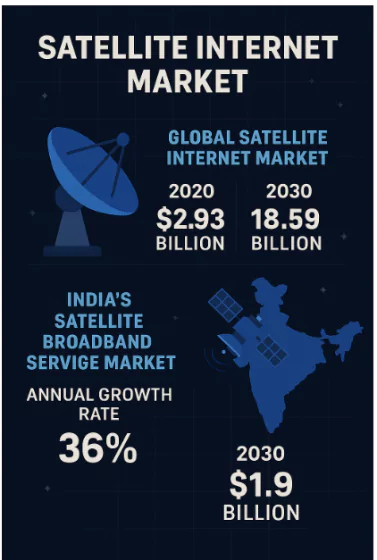SpaceX’s recent partnerships with Airtel and Jio to expand Starlink services across India could be looked at as a fundamental shift in the conceptions of connectivity, national sovereignty, and economic power in the digital age.
About Satellite Internet
- It is a type of internet connection that uses satellites in space to provide internet access to users on Earth.
- It is primarily used in areas where traditional broadband internet infrastructure, such as fiber optics or copper cables, is unavailable or difficult to deploy, such as rural, remote, or underserved regions.
Key Features of Satellite Internet

- How It Works: It involves three main components:
- User Terminal (Satellite Dish): Users require a satellite dish at their location, which transmits data requests to a satellite and receives data in return.
- Satellites in Orbit: Satellites act as relay points. For example, satellites in Low Earth Orbit (LEO), used by providers like Starlink, orbit approximately 500-2,000 km above Earth, offering lower latency compared to traditional Geostationary (GEO) satellites positioned around 35,786 km away.
- Ground Stations (Gateway): Ground stations connect satellites to the global internet. User data travels from the satellite to these ground stations, which then route data through terrestrial networks to the intended destination.
- Types of Satellite Orbits:
- Geostationary Orbit (GEO): Satellites are positioned at around 35,786 km above Earth, moving with the Earth’s rotation.
- These satellites provide wide coverage but have higher latency (delay) due to the long distance.
- Low Earth Orbit (LEO): Satellites are positioned closer to Earth, typically at altitudes of 500-2,000 km.
- LEO satellites offer lower latency and faster speeds but require large constellations to provide global coverage.
- Key Providers:
- SpaceX’s Starlink: Provides low-latency broadband internet using a large network of LEO satellites.
- OneWeb: Another major player in LEO satellite internet, aimed at providing global coverage.
- Amazon’s Project Kuiper: A planned constellation to offer broadband internet using LEO satellites.
Advantages of satellite internet
- Connectivity in Remote and Rural Areas: Satellite internet bypasses the need for terrestrial infrastructure like fiber cables.
- As of December 2024, according to data from the Registrar General of India over 18,000 villages still lack mobile connectivity; satellite internet can bridge this gap.
- Disaster-Resilient Communication: During natural disasters, ground infrastructure often fails; satellites offer uninterrupted communication.
- Starlink was also used during Hurricane Ian in the U.S. (2022) to restore communication in affected areas.
- Fast Deployment: Can be rolled out quickly in areas lacking infrastructure, compared to laying fiber optic cables which is time-consuming and costly.
- Laying 1 km of fiber cable in tough terrain can cost ₹10–15 lakh, while satellite dishes can be deployed within days.
- Strategic and Military Utility: Satellite internet ensures secure communication for armed forces in border or maritime zones.
- Ukraine used Starlink during the 2022 war to maintain battlefield communications after fiber and cellular networks were destroyed.
- Supports Remote Education and Telemedicine: Enables access to online education, digital classrooms, and virtual health consultations in backward areas.
- IN-SPACe grants authorisation to OneWeb India, takes first step for 24×7 internet in rural India.
- Boost to Space Economy and Innovation: Growth in satellite internet boosts investment in space tech, start-ups, and manufacturing.
- The global satellite internet market is projected to reach $18.59 billion by 2030 (Allied Market Research).
limitations of Satellite Internet
- High Cost of Access: Equipment and subscription costs are much higher than terrestrial options. May worsen the digital divide unless subsidized.
- Starlink’s one time hardware costs are ₹25,000-₹35,000, and monthly charges exceed ₹7,000 — unaffordable for most rural Indians.
- Weather Dependency: Satellite signals can be disrupted by rain, storms, or heavy cloud cover, affecting reliability.
- This is known as “rain fade” — particularly impacts Ku-band and Ka-band satellites used in high-speed internet.
- Latency and Bandwidth Issues: Geostationary satellites (35,786 km above Earth) have high latency (~600ms), making them unsuitable for real-time apps like gaming or video calls.
- Even with LEO systems like Starlink, latency is better (~20-40ms) but can fluctuate.
- Space Debris and Orbital Congestion: Thousands of satellites in Low Earth Orbit (LEO) raise collision risks and threaten sustainability of outer space.
- As of 2024, Starlink has launched over 7,000 satellites; OneWeb, Amazon Kuiper, and others are adding more.
- NASA warns of a “Kessler Syndrome” scenario: chain-reaction collisions in space.
- Cybersecurity and Sovereignty Risks: Signals transmitted from space are vulnerable to cyberattacks and surveillance.
- Concerns arose in India about using U.S.-based Starlink, fearing foreign control over critical communication infrastructure.
- In 2022, Russia attempted jamming of Starlink services used in Ukraine.
- Regulatory and Legal Complexities: Cross-border satellite signals pose challenges in spectrum regulation, licensing, and data governance.
- India has stringent rules on foreign satellite services — needing clearance from DoT, ISRO, and the Ministry of Home Affairs.
- Lack of global coordination can lead to spectrum interference and disputes.
Geopolitical Implications of Satellite Internet
- Digital Sovereignty vs. Tech Dependency: Countries risk losing control over data and communication infrastructure by relying on foreign satellite systems.
- India partnering with Starlink (US-based) raises concerns about foreign influence over national networks.
- Private Players with Nation-State Power: Companies like SpaceX now control infrastructure traditionally managed by states. Corporations could become geopolitical actors.
- Elon Musk’s Starlink restricted Ukraine’s access during a military operation (2022), showing private veto over national security decisions.
- New Axis of Global Influence: Satellite constellations are becoming tools of soft power and global dominance.
- USA (Starlink (SpaceX), Amazon Kuiper); China (GuoWang constellation); EU (IRIS² initiative), These networks project influence into cyberspace and outer space domains.
- Space as a Strategic Domain: LEO satellite networks have dual-use (civil + military) applications.
- Countries now view space-based internet as part of their strategic infrastructure.
- Multipolar Tech Alliances: Countries are aligning tech infrastructure with political blocs.
- Example: India aligning with U.S. (Starlink, OneWeb) rather than China’s GuoWang — reflecting a democratic tech alliance in the Indo-Pacific.
- Global Regulatory Vacuum: No robust international treaty governs satellite internet operations, spectrum use, or space traffic management.
- Rising risk of orbital conflicts and cyber interference.
- Digital Colonialism Debate: Critics argue satellite internet could become a form of digital imperialism, where control of data and networks lies with powerful foreign firms.
- Requires data localization policies, tech transfer, and local stakeholder involvement to mitigate.
Economic Value vs. Geopolitical Control Framework
- Digital Sovereignty (High Economic + High Geopolitical Control): China’s GuoWang aims for state-controlled dominance.
- Market Dominance (High Economic + Low Geopolitical Control): Starlink’s current position; India mitigates risks via domestic partnerships.
- Strategic Asset (Low Economic + High Geopolitical Control): India’s indigenous satellite efforts (ISRO) are economically suboptimal but strategically vital.
- Marginal Presence (Low Economic + Low Geopolitical Control): Emerging players like Amazon’s Kuiper.
India’s Path to Digital Sovereignty
- Digital Sovereignty: The ability of a country to exercise control over digital infrastructure, data, platforms, and technologies within its borders — ensuring strategic autonomy, privacy, and national security.
- Why Digital Sovereignty Matters for India?
- Strategic Autonomy: Avoid dependency on foreign technologies.
- Data Protection: Safeguard citizen data and national databases.
- Cybersecurity: Mitigate threats from foreign surveillance or cyber warfare.
- Digital Economy: Retain value creation within Indian borders.
India’s Steps Toward Digital Sovereignty
- Legislative & Policy Initiatives
- Digital Personal Data Protection Act, 2023 – Introduces data localization and user consent frameworks.
- National Cyber Security Policy (under revision) – Aims for critical infrastructure protection.
- Draft Indian Telecommunication Bill, 2023 – Regulates digital and satellite networks.
- National Digital Communications Policy, 2018 – Supports indigenous digital infrastructure.
- Digital Public Infrastructure (DPI):
- India Stack: Aadhaar, UPI, DigiLocker, CoWIN — publicly-owned digital infrastructure.
- Promotes tech for public good, reduces reliance on foreign Big Tech.
- Atmanirbhar Bharat in Tech: Promotion of semiconductor manufacturing (ISMC, Micron, Vedanta-Foxconn).
- Boosting indigenous satellite systems like GSAT, NavIC (IRNSS), and projects like Matsya 6000.
- Development of Bharat Operating System Solutions (BOSS) — a Linux-based OS.
- State-owned telecom operator BSNL has also launched its own direct-to-device satellite internet service
- Space & Satellite Internet Strategy: Empowering IN-SPACe for regulating private space activity.
- Encouraging private-sector satellite broadband while developing ISRO-led alternatives.
- Rejecting unrestricted Starlink entry shows cautious diplomacy.
- Data Localization & Sovereign Clouds: RBI mandates local storage of payments data.
- Govt. promoting MeghRaj cloud infrastructure for e-governance services.
Global Internet Governance
- It involves how the Internet is managed globally — including standards, security, access, and usage, involving governments, private sector, civil society, academia, and technical community.
Key Global Institutions
| Institution |
Role |
| ICANN (Internet Corporation for Assigned Names and Numbers) |
Manages IP addresses and domain names. Based in the US. |
| ITU (International Telecommunication Union) |
UN agency that deals with global telecom standards and coordination. |
| IGF (Internet Governance Forum) |
UN-backed multi-stakeholder platform for dialogue on internet governance. |
| W3C (World Wide Web Consortium) |
Sets web standards like HTML, HTTP, etc. |
| IETF (Internet Engineering Task Force) |
Develops technical protocols for internet architecture. |
Models of Governance
| Model |
Features |
Supported by |
| Multi-stakeholder Model |
Inclusive — govts, private, civil society participate. |
USA, EU, India |
| Multilateral Model |
Govt-led, sovereign-centric. |
China, Russia, some developing nations |
| Hybrid Models |
Combine state oversight with private implementation. |
Many emerging democracies |
Way Forwards
- Balanced Policy Approach: India must balance national security concerns with openness to global innovation.
- Strategic partnerships (like with Starlink, OneWeb) should be paired with clear regulatory safeguards and tech transfer agreements.
- Accelerate Indigenous Capability: Strengthen ISRO & private players via Public-Private Partnerships (PPP) to develop LEO satellite constellations.
- Boost funding for space-tech start-ups (e.g. Pixxel, Astrome) and develop a national satellite broadband roadmap.
- Unified and Transparent Regulatory Framework: Create a single-window clearance system for satellite internet licensing via IN-SPACe.
- Finalize the Space Activities Bill and update the satellite communication policy to provide legal clarity.
- Strengthen Data Sovereignty & Cybersecurity: Enforce data localization norms, end-to-end encryption, and mandatory security audits for foreign satellite operators.
- Develop sovereign satellite communication infrastructure for critical and defense sectors.
- Bridge the Digital Divide Proactively: Launch a Satellite Internet for Bharat scheme to subsidize access in remote areas.
- Leverage Universal Service Obligation Fund (USOF) to fund ground terminals in unconnected villages.
- Push for Global Governance & Norms: Lead initiatives at ITU and IGF to develop binding international norms on spectrum sharing, satellite traffic, and cybersecurity.
- Promote a Global Code of Conduct for Space Internet aligned with India’s democratic and developmental values.
- Integrate Satellite Internet with Digital Public Infrastructure (DPI): Use satellite broadband to power rural CoWIN, DigiLocker, e-Sanjeevani, PM-WANI etc.
- Make satellite internet an enabler of inclusive Digital India 2.0.
Conclusion
Satellite Internet can either bridge the digital divide or reinforce inequalities. India must balance connectivity benefits with strategic autonomy. Effective global governance is needed to prevent a “tragedy of the orbital commons.”
Additional Reading: India’s Stand on Digital Sovereignty
![]() 4 Apr 2025
4 Apr 2025


